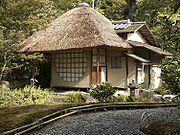
Kodai-ji
Encyclopedia
, formally identified as , is a temple of the Rinzai school
of Zen
Buddhism
in Higashiyama-ku
, Kyoto
, Japan
—the largest subtemple of the Kennin-ji
branch. It was established in 1606 by Nene
(often known by the title Kita no Mandokoro
, and who had taken the name Kōdai-in), the widow of Toyotomi Hideyoshi
, to pray for her late husband. The principal image is a statue of Shaka
.
 The temple possesses a number of objects designated as Important Cultural Assets. Among these are the Main Gate and the Spirit Hall, noted for its use of maki-e
The temple possesses a number of objects designated as Important Cultural Assets. Among these are the Main Gate and the Spirit Hall, noted for its use of maki-e
. The temple is nicknamed the maki-e temple." It also holds paintings, including one of Hideyoshi, as well as textiles, and a bronze bell
with an inscription dating it to 1606.
35.000761°N 135.781114°W
Rinzai school
The Rinzai school is , one of three sects of Zen in Japanese Buddhism.Rinzai is the Japanese line of the Chinese Linji school, which was founded during the Tang Dynasty by Linji Yixuan...
of Zen
Zen
Zen is a school of Mahāyāna Buddhism founded by the Buddhist monk Bodhidharma. The word Zen is from the Japanese pronunciation of the Chinese word Chán , which in turn is derived from the Sanskrit word dhyāna, which can be approximately translated as "meditation" or "meditative state."Zen...
Buddhism
Buddhism
Buddhism is a religion and philosophy encompassing a variety of traditions, beliefs and practices, largely based on teachings attributed to Siddhartha Gautama, commonly known as the Buddha . The Buddha lived and taught in the northeastern Indian subcontinent some time between the 6th and 4th...
in Higashiyama-ku
Higashiyama-ku, Kyoto
' is one of the eleven wards in the city of Kyoto, in Kyoto Prefecture, Japan. It was created in 1929 when it was split off from Shimogyō-ku. During the years 1931 to 1976 it also covered the area of present-day Yamashina-ku, which was an independent town until its merger into the city in 1931...
, Kyoto
Kyoto
is a city in the central part of the island of Honshū, Japan. It has a population close to 1.5 million. Formerly the imperial capital of Japan, it is now the capital of Kyoto Prefecture, as well as a major part of the Osaka-Kobe-Kyoto metropolitan area.-History:...
, Japan
Japan
Japan is an island nation in East Asia. Located in the Pacific Ocean, it lies to the east of the Sea of Japan, China, North Korea, South Korea and Russia, stretching from the Sea of Okhotsk in the north to the East China Sea and Taiwan in the south...
—the largest subtemple of the Kennin-ji
Kennin-ji
, is a historic Zen Buddhist temple in Higashiyama, Kyoto, Japan, near Gion. It is considered to be one of the so-called Kyoto Gozan or "five most important Zen temples of Kyoto".-History:...
branch. It was established in 1606 by Nene
Nene (person)
or One was an aristocratic lady during the Sengoku and Edo periods of Japanese history known for her intelligence and marriage to Toyotomi Hideyoshi...
(often known by the title Kita no Mandokoro
Mandokoro
was the chief governing body of an important family or monastic complex in ancient Japan. This name was borrowed for the administrative department of the Shogunate in feudal times....
, and who had taken the name Kōdai-in), the widow of Toyotomi Hideyoshi
Toyotomi Hideyoshi
was a daimyo warrior, general and politician of the Sengoku period. He unified the political factions of Japan. He succeeded his former liege lord, Oda Nobunaga, and brought an end to the Sengoku period. The period of his rule is often called the Momoyama period, named after Hideyoshi's castle...
, to pray for her late husband. The principal image is a statue of Shaka
Gautama Buddha
Siddhārtha Gautama was a spiritual teacher from the Indian subcontinent, on whose teachings Buddhism was founded. In most Buddhist traditions, he is regarded as the Supreme Buddha Siddhārtha Gautama (Sanskrit: सिद्धार्थ गौतम; Pali: Siddhattha Gotama) was a spiritual teacher from the Indian...
.

Maki-e
is Japanese lacquer sprinkled with gold or silver powder as a decoration using a makizutsu or a kebo brush. The technique was developed mainly in the Heian Period and blossomed in the Edo Period...
. The temple is nicknamed the maki-e temple." It also holds paintings, including one of Hideyoshi, as well as textiles, and a bronze bell
Bell (instrument)
A bell is a simple sound-making device. The bell is a percussion instrument and an idiophone. Its form is usually a hollow, cup-shaped object, which resonates upon being struck...
with an inscription dating it to 1606.
See also
- For an explanation of terms concerning Japanese Buddhism, Japanese Buddhist art, and Japanese Buddhist temple architecture, see the Glossary of Japanese BuddhismGlossary of Japanese BuddhismThis is the glossary of Japanese Buddhism, including major terms the casual reader might find useful in understanding articles on the subject. Words followed by an asterisk are illustrated by an image in one of the photo galleries...
.
External links
- 高台寺 Official site (in Japanese and Chinese)
35.000761°N 135.781114°W

